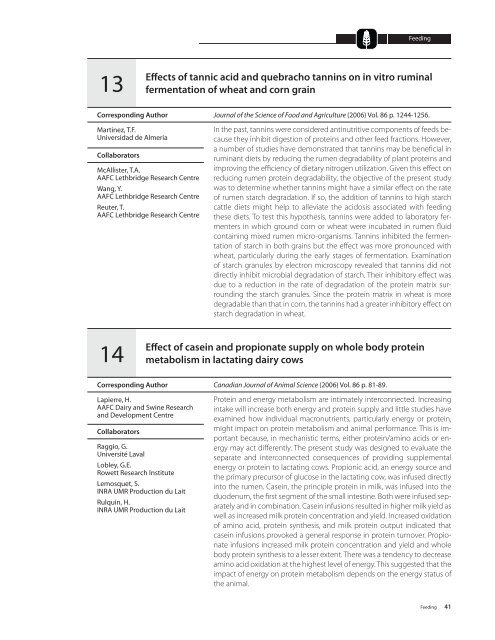A52-75-2007E.pdf - AgroMedia International Inc
A52-75-2007E.pdf - AgroMedia International Inc
A52-75-2007E.pdf - AgroMedia International Inc
Create successful ePaper yourself
Turn your PDF publications into a flip-book with our unique Google optimized e-Paper software.
Feeding13Effects of tannic acid and quebracho tannins on in vitro ruminalfermentation of wheat and corn grainCorresponding AuthorMartinez, T.F.Universidad de AlmeriaCollaboratorsMcAllister, T.A.AAFC Lethbridge Research CentreWang, Y.AAFC Lethbridge Research CentreReuter, T.AAFC Lethbridge Research CentreJournal of the Science of Food and Agriculture (2006) Vol. 86 p. 1244-1256.In the past, tannins were considered antinutritive components of feeds becausethey inhibit digestion of proteins and other feed fractions. However,a number of studies have demonstrated that tannins may be beneficial inruminant diets by reducing the rumen degradability of plant proteins andimproving the efficiency of dietary nitrogen utilization. Given this effect onreducing rumen protein degradability, the objective of the present studywas to determine whether tannins might have a similar effect on the rateof rumen starch degradation. If so, the addition of tannins to high starchcattle diets might help to alleviate the acidosis associated with feedingthese diets. To test this hypothesis, tannins were added to laboratory fermentersin which ground corn or wheat were incubated in rumen fluidcontaining mixed rumen micro-organisms. Tannins inhibited the fermentationof starch in both grains but the effect was more pronounced withwheat, particularly during the early stages of fermentation. Examinationof starch granules by electron microscopy revealed that tannins did notdirectly inhibit microbial degradation of starch. Their inhibitory effect wasdue to a reduction in the rate of degradation of the protein matrix surroundingthe starch granules. Since the protein matrix in wheat is moredegradable than that in corn, the tannins had a greater inhibitory effect onstarch degradation in wheat.14Effect of casein and propionate supply on whole body proteinmetabolism in lactating dairy cowsCorresponding AuthorLapierre, H.AAFC Dairy and Swine Researchand Development CentreCollaboratorsRaggio, G.Université LavalLobley, G.E.Rowett Research InstituteLemosquet, S.INRA UMR Production du LaitRulquin, H.INRA UMR Production du LaitCanadian Journal of Animal Science (2006) Vol. 86 p. 81-89.Protein and energy metabolism are intimately interconnected. <strong>Inc</strong>reasingintake will increase both energy and protein supply and little studies haveexamined how individual macronutrients, particularly energy or protein,might impact on protein metabolism and animal performance. This is importantbecause, in mechanistic terms, either protein/amino acids or energymay act differently. The present study was designed to evaluate theseparate and interconnected consequences of providing supplementalenergy or protein to lactating cows. Propionic acid, an energy source andthe primary precursor of glucose in the lactating cow, was infused directlyinto the rumen. Casein, the principle protein in milk, was infused into theduodenum, the first segment of the small intestine. Both were infused separatelyand in combination. Casein infusions resulted in higher milk yield aswell as increased milk protein concentration and yield. <strong>Inc</strong>reased oxidationof amino acid, protein synthesis, and milk protein output indicated thatcasein infusions provoked a general response in protein turnover. Propionateinfusions increased milk protein concentration and yield and wholebody protein synthesis to a lesser extent. There was a tendency to decreaseamino acid oxidation at the highest level of energy. This suggested that theimpact of energy on protein metabolism depends on the energy status ofthe animal.Feeding 41





